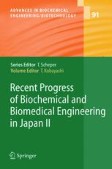Search
Search Results
-
Deconvolution Microscopy
Since its introduction in 1983, deconvolution microscopy has become a key image-processing tool for visualizing the cellular structures of fixed and...
-
Application of Knowledge Information Processing Methods to Biochemical Engineering, Biomedical and Bioinformatics Fields
In biochemical and biomedical engineering fields there are a variety of phenomena with many complex chemical reactions, in which many genes and...
-
Total Internal Reflection Fluorescence Microscopy in Single Molecule Nanobioscience
Recent development in total internal reflection fluorescence microscopy (TIRFM) has made it possible to directly monitor the behaviors of...
-
Tracking Movement in Cell Biology
This article is an overview of techniques for measuring movement of proteins, vesicles and cells using digital image processing. Diverse techniques...
-
Cell-free Protein Synthesis Systems: Increasing their Performance and Applications
The Escherichia coli cell-free protein synthesis system can now be used for various proteins that need special requirements, such as disulfide bond...
-
Fluorescence Lifetime Imaging Microscopy (FLIM)
Fluorescence lifetime imaging microscopy (FLIM) is a technique to map the spatial distribution of nanosecond excited state lifetimes within...
-
Spectral Imaging and Linear Unmixing in Light Microscopy
Fluorescence microscopy is an essential tool for modern biological research. The wide range of available fluorophores and labeling techniques allows...
-
Bioprocess Monitoring Using Near-Infrared Spectroscopy
Near-infrared spectroscopy (NIR) is a nondestructive analytical technique that has been used for simultaneous prediction of the concentrations of...
-
Metabolic Flux Analysis Based on 13C-Labeling Experiments and Integration of the Information with Gene and Protein Expression Patterns
The recent progress on metabolic systems engineering was reviewed, in particular focusing on the metabolic flux analysis (MFA) based on the...
-
Transgenic Birds for the Production of Recombinant Proteins
Transgenic birds were expected to be an excellent transgenic bioreactor for the production of recombinant pharmaceutical proteins. However, the only...
-
Cofactor Regeneration at the Lab Scale
Progress made in lab-scale applications of various coenzyme regeneration systems over the last two decades has mainly focused on the applications of...
-
Degradation and Preservation of Organic Matter in Marine Sediments
Organic matter that is deposited in aquatic sediments is subject to an intense diagenetic reactor that determines how much organic carbon is...
-
The Material-Independent Signatures of Life.Forensic Tools of Astrobiology
Biological life is intimately related to the geochemical conditions on Earth and is fit for this planet’s energy flux. It has often been suggested...
-
The Early History of Bioenergy
Energy is most commonly defined as the potential to do work. The maintenance of the living state requires a constant flow of energy through the...
-
Assembling the Early Puzzle of Life
So far no theory, no approach, no set of formulas, and no blackboard scheme have been found satisfactory in explaining the origin of life. The...
-
The Early History of Bio-Information
In a general sense, the information level of a structure equals the minimum number of instructions needed to specify the structure (Orgel 1973). The...
-
From Stationary to Instationary Metabolic Flux Analysis
Metabolic flux analysis using 13C labeled substrates is an important tool for metabolic engineering. Although it has now been evolving for more than...
-
Applying Metabolic Profiling Techniques for Stimulus-Response Experiments: Chances and Pitfalls
So far it is mainly transcriptome and proteome analysis that has been applied to elucidate the correlation between genotype and phenotype although...
-
Biochemical Reaction Engineering and Process Development in Anaerobic Wastewater Treatment
Developments in production technology have frequently resulted in the concentrated local accumulation of highly organic-laden wastewaters. Anaerobic...
-
Biochemical Engineering Aspects of Expanded Bed Adsorption
The economic feasibility of a biotechnological production process is directly linked to the number and efficiency of the processes required during...
